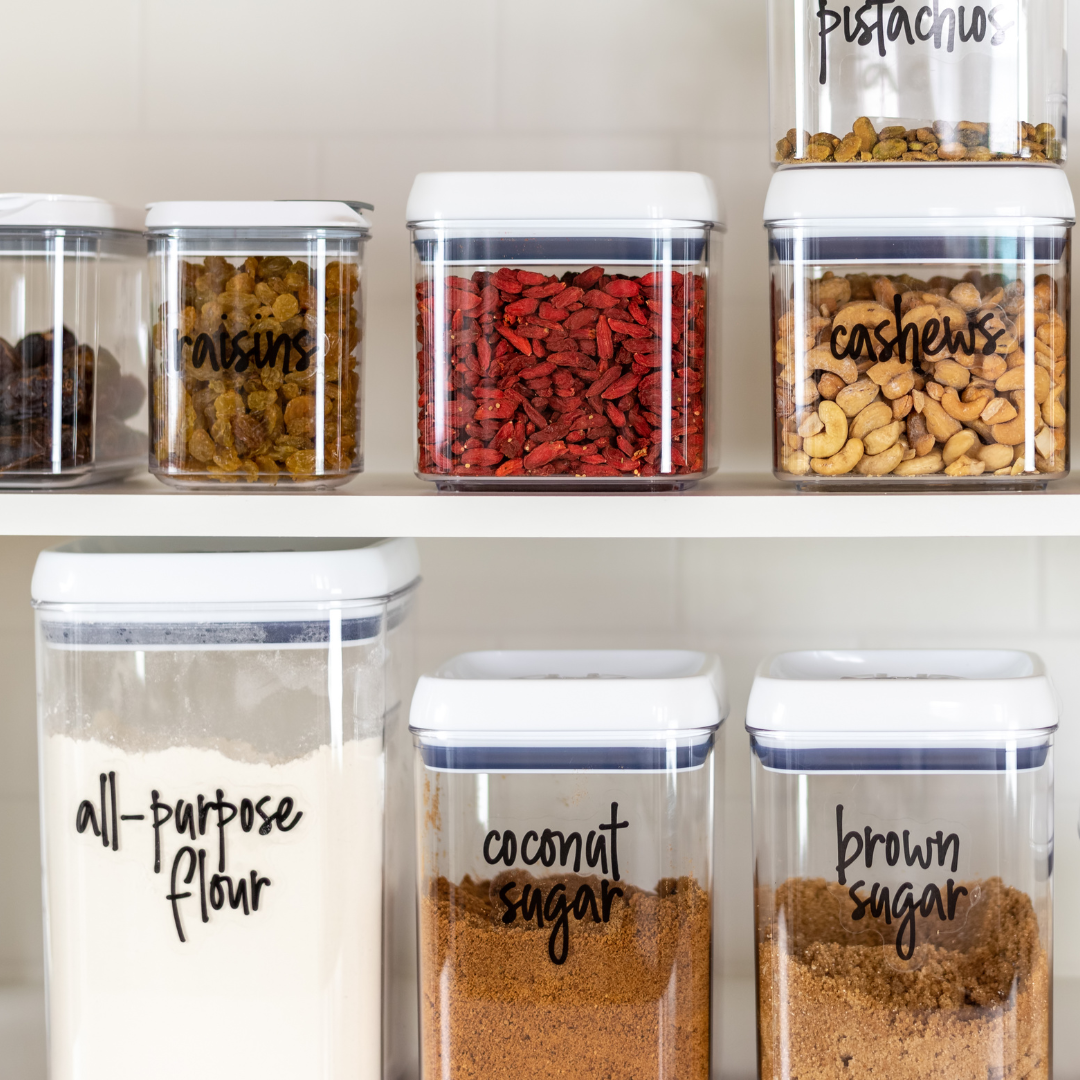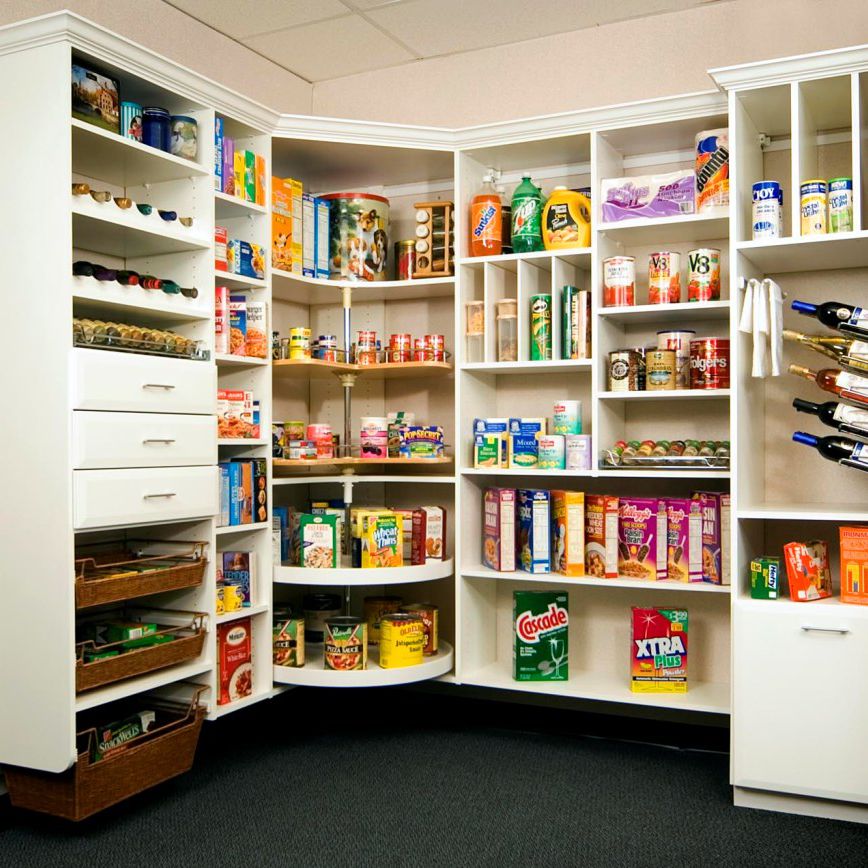A kitchen pantry typically stores food items (such as dried goods, and a selection of fruits) and other supplies regularly used in the kitchen.
Read on to find out more about what you can safely store in a kitchen pantry.
What is in a kitchen pantry?
Baking Staples

Baking goods include different types of flour, white and brown sugar, powdered sugar, baking powder, baking soda, yeast, vanilla extract, cream of tartar, unsweetened cocoa powder, and chocolate chips. Other items used in baking include evaporated milk, baking sheets, piping bags, and tips.
Regular baking activities may prompt the need for shredded coconut, chia seeds, butter, vegetable shortening, rolled oats, gelatin, and cornmeal. Dried fruits and a variety of nuts can be useful bonuses in any baker’s pantry. These can include walnuts, pecans, raisins, dates, cranberries, and figs.
Condiments and Sweeteners

Kitchen pantries also contain items paired with food to enhance the flavor of cooked items. These include ketchup, hot sauce, peanut butter, almond butter, balsamic vinegar, mayonnaise, and salsa.
Barbecue sauce, ranch dressing, Caesar dressing, Dijon mustard, horse radish, Worcestershire sauce, and marinara sauce are commonly featured in modern pantries.
Pantries also contain sweeteners like granulated sugar, honey, maple syrup, caramel, chocolate sauce, and agave syrup.
Herbs and Spices

Pantries are an ideal storage space for dried herbs and spices which need to be stored in a cool dry place. These include bay leaves, crushed pepper, curry powder, ground ginger, dried oregano, paprika, rosemary, chili powder, cayenne paper, fennel, garlic powder, and cinnamon.
Common spices also include ground cloves, ginger, thyme, sesame seeds, nutmeg, cardamom, turmeric, saffron, star anise, allspice, onion powder, mustard seeds, and cumin.
Pantries help to keep these dried spices away from moisture and direct sunlight.
Canned Goods

Many food items are canned and do not require refrigeration to maintain their taste, appearance, and longevity. These canned goods include beans, vegetables, olives, capers, salsa, tuna, anchovy fillets, tomato paste, and meat broth.
Cooking Oils

Depending on taste, nutritional value, and cooking preferences, you may want to keep different oils around the kitchen poised for different uses. These include natural vegetable oil, olive oil, canola oil, peanut oil, and coconut oil.
Storage in a cool dry place is essential to maintaining the desirable properties of cooking oils, since they may become denatured when stored in direct sunlight or at extremely low or high temperatures.
Grains, Legumes, and Pasta

Pasta and grains are a very quick way to whip up a main or side dish, based on the minimal preparation and short cook time required. They can be combined with many common spices and canned goods to ensure a hearty, delicious, and satisfying meal on a whim.
Delicious grains like rice, granola, breakfast cereals, barley, quinoa, oats, and millet are reliable pantry items. Remember to store them in clear, airtight containers which can keep moisture out of them once you have opened their original packages.
Dried pasta like spaghetti, lasagna, ravioli, rigatoni, linguine, macaroni, and fettuccine can last for several months if properly stored in a moisture-free and cool pantry.
It is ill-advised to store dried pasta products in a refrigerator because they soak up moisture that affects their taste, appearance, and longevity.
Snacks

Many non-perishable snacks can be safely stocked in a pantry. These include plastic-packaged snacks like crisps, dried fruit, fruit gummies, popcorn, pretzels, granola bars, and a variety of nuts.
Other good options are crackers, cookies and biscuits, marshmallows, and a selection of probiotic bars.
Cleaning Products

You can store some cleaning products and equipment in your kitchen pantry. However, not all products can be safely stored around food, so ensure you store kitchen cleaning supplies only.
Remember not to keep strong-smelling cleaning products in an enclosed pantry, as the smell may stick on your food items. While it may not affect the quality of food, it is quite irritating to eat your favorite food while ignoring the strong smell of chemicals and soap.
Can I store fruits in my Kitchen pantry?

You can indeed store some fruits in a pantry, but remember to avoid mixing some fruits. Fruits produce large amounts of ethylene gas, a natural hormone that makes fruits ripen quicker.
For this reason, keep fruits like apples and bananas separate from each other to prevent over-ripening that may spoil the fruits.
There are climacteric and non-climacteric fruits, and you should consider this difference when storing fruits in a pantry.
Climacteric fruits ripen as soon as they are picked off the stem. These include apples, mangoes, bananas, avocados, and pears. These fruits are sensitive to ethylene gas and should be stored far apart from each other and away from direct sunlight.
Non-climacteric fruits are unable to ripen once they are taken off of their respective plants. They do all their maturing before making their way to markets and pantries. These fruits are therefore not affected by ethylene gas and can be stored together. Non-climacteric fruits include berries, cherries, citrus fruits, and pineapples.
An important point to remember is that you should not wash fruit before storing it in a pantry, rather wash whichever fruit you want right before cutting and serving it. Washing fruit introduces moisture that creates ideal grounds for fruit to spoil, mostly resulting from bacterial growth.
Although you can store fruit in your pantry at room temperature, there is more to it if you intend to store fruits for long periods. Most fruits tend to last longer when refrigerated, and a lot of these require fully ripening before being stored in the fridge. Storing certain fruits while unripe can cause freezer burn which adversely affects their texture and taste.
Fruits that you can leave in the pantry to ripen before refrigerating include mangoes, bananas, peaches, plums, papaya, and apricots. Once ripe, they can typically last between a week to four weeks in the fridge.
Conclusion
Pantries are a versatile and useful placement solution for your kitchen. They can often hold large amounts of food, condiments and spices, cookware, and occasionally used kitchen appliances.
Consider some of our kitchen designs to work out some pantry design ideas that suit your food items and preferences.






15 comments
Thomasguace
Worrying https://www.nothingbuthemp.net/products/cordyceps-mushroom-gummies-with-thc-cbc has been thoroughly the journey. As someone acerbic on imbecile remedies, delving into the world of hemp has been eye-opening. From CBD lubricator to hemp seeds and protein capacity, I’ve explored a variety of goods. Undeterred by the gallimaufry local hemp, researching and consulting experts be enduring helped nautical con this burgeoning field. Complete, my meet with with hemp has been positive, gift holistic well-being solutions and sustainable choices.
TerryHoums
Annoying https://www.nothingbuthemp.net/products/thc-cbn-tincture-for-sleep has been quite the journey. As someone acerbic on imbecile remedies, delving into the epoch of hemp has been eye-opening. From CBD grease to hemp seeds and protein powder, I’ve explored a variety of goods. Despite the confusion surrounding hemp, researching and consulting experts be enduring helped cruise this burgeoning field. Complete, my knowledge with hemp has been decided, gift holistic well-being solutions and sustainable choices.
TerryHoums
Annoying https://www.nothingbuthemp.net/pages/thc-delivery-service has been thoroughly the journey. As someone impassioned on habitual remedies, delving into the epoch of hemp has been eye-opening. From CBD lubricant to hemp seeds and protein potential, I’ve explored a variety of goods. Notwithstanding the gallimaufry adjacent hemp, researching and consulting experts have helped handle this burgeoning field. Comprehensive, my experience with hemp has been decided, offering holistic well-being solutions and sustainable choices.
TerryHoums
Annoying https://www.nothingbuthemp.net/products/200mg-blue-dream-thc-gummies-20-pack has been absolutely the journey. As someone impassioned on imbecile remedies, delving into the the human race of hemp has been eye-opening. From CBD grease to hemp seeds and protein bray, I’ve explored a disparity of goods. Undeterred by the gallimaufry adjacent hemp, researching and consulting experts be enduring helped navigate this burgeoning field. Entire, my meet with with hemp has been sure, oblation holistic well-being solutions and sustainable choices.
EdwardNup
I’ve recently started using https://elevateright.com/thca-flower/ , and they’ve exceeded my expectations. From Delta 8 products to HHC products, the benefits are undeniable. They forbear restrict lay stress, improve catnap, and despite that smooth opulence minor aches. What I enjoyment most is that they’re natural and don’t commit me sympathies numbed or absent from of it. The dignity of hemp products makes a tremendous imbalance, so I always look looking for trusted brands. Whether you’re new to hemp or savvy, these products are a game-changer seeking overall wellness.
Leave a comment
This site is protected by hCaptcha and the hCaptcha Privacy Policy and Terms of Service apply.